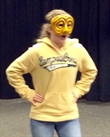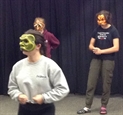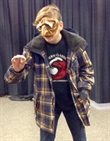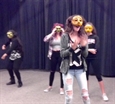




Commedia Dell'Arte (the art of the professional)
From 1550 to 1750, commedia dell’arte enriched the stages of Western Europe and is known to have influenced the work of Shakespeare and Moliere. It is the beginning of several innovations that lead to what we now know as theatre, film and television. It is the first time we see the introduction of a professional guild with such things as injury insurance, a unionized atmosphere to protect actors, the renting or owning of spaces in which the audience will pay first and then see the play. It is the first time women are seen performing on stage; one woman, Isabella Andreini (1562-1604), surpassing many of her male counterparts and transforming female roles such as the role of Filli who “does not succumb to the misogynist snares of the satyr, but rather turns the tables on him, thereby inverting and satirizing a standard element of pastoral literature.”
The workshops deal with six of the stock characters. It is emphasized that the students should seek to find their own style of performing the character while at the same time working within the structure of the stock personality. The female students are encouraged to find the female counterpart when playing the mask rather than crossing sex and playing a male character. There are of course female characters however these are traditionally unmasked characters and it is one of the main tasks of the workshop series to train the students in the use of mask. Since time is a factor characters such as Columbina are not normally taught although the female lover is. A typical five day project will see the students introduced to the following elements of the Commedia;
1) The physical rhythms of the characters along with gaining a sense of the character’s voice. The voice comes naturally out of the physicality of the character and allows the student to work within their natural vocal range. They will learn to modify to some degree the traditional rhythm of the character and codify it for the purpose of being able to reproduce it steadily.
2) Learn how to present the mask while speaking dialogue.
3) Exposure to the mask itself while wearing it and improvising in front of the class attempting to bring together the previous technique lessons.
4) The students will then look at how to construct a lazzo. This leads to the project presentation which will be performed in pairs or trios. A simple selection of lazzi scenarios will be provided to them. They work in pairs or as a trio of characters.
5) Presentation of the lazzis to the class.
Additional days can be incorporated into the project according to the teacher’s desired end result and of course budgeting. For each day added the more detail in various aspects of the first two points above and/or exposure to wearing the mask and improvising. Additional days can be broken up to allow the teacher and students to work on projects longer and having the instructor return to either further the work or view final presentations. These in between days without the guest artist allows for two things to occur; lower overall cost to the project and an opportunity to teachers to teach the techniques they have observed giving themselves a better understanding of teaching the art.